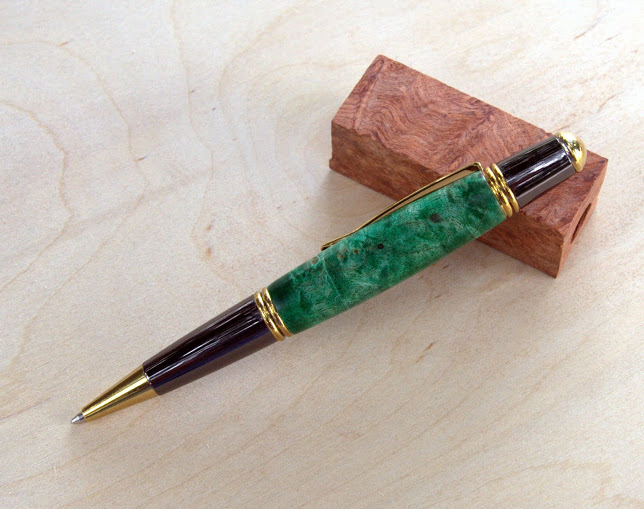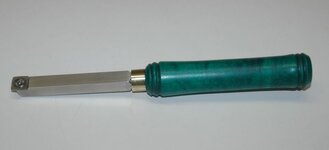I have an idea about dying a light colored blank such as red oak or maybe ash but I don't know if it will work. Here is my idea. Cut and drill the blank. Mix up the dye alcohol or maybe water based. Put the dye and blank in a pressure pot and pressurize it. My thinking is that the pressure would force the dye in to the wood and maybe color the all the way through.
You are using an out of date browser. It may not display this or other websites correctly.
You should upgrade or use an alternative browser.
You should upgrade or use an alternative browser.
Dying light colored blanks????
- Thread starter Band Saw Box
- Start date
Signed-In Members Don't See This Ad
Signed-In Members Don't See This Ad
dartman
Member
I got nothing but will be watching this thread.
longbeard
Member
I have not done this but, I'm thinking vacum over pressure would be better to get the color to penetrate the blank. I've also seen where guys have used food coloring dye also. Just my .02 cents worth
Last edited:
76winger
Member
I don't know because I've never done it, but this sounds like the same process people use for stabilizing wood: using pressure or vacuum to get the stabilizing agent to penetrate into the wood. In your case you'd just be infusing dye instead of stabilizer.
I've also purchased pre-dyed blanks and have to assume the above is the process that was used to get the dye all through that wood. How else would they go about it?
I've also purchased pre-dyed blanks and have to assume the above is the process that was used to get the dye all through that wood. How else would they go about it?
gbpens
Member
Vacuum will work better than pressure for getting the dye clear through. Try Curtis (MesquiteMan).
Why not wait until you turn it and then color it with an alcohol based dye? Process is simple...dye it black first...sand it back until only black highlights remain. Add dye 2-3 times until desired color level is achieved. hit with steel wool of your choice and finish as usual. No vacuum, no pressure. We do this with platters, pen blanks and bowls all the time.
walshjp17
Member
Why not wait until you turn it and then color it with an alcohol based dye? Process is simple...dye it black first...sand it back until only black highlights remain. Add dye 2-3 times until desired color level is achieved. hit with steel wool of your choice and finish as usual.
This is exactly the method a member of one of the local woodturning clubs uses for dying his sushi platters. Once he finishes with the dye, sanding, steel wool bits, he then sprays a few coats lacquer on the platters. They come out spectacular.
Always start with black and then work up to the reds, greens, blues, yellows.
sbwertz
Member
This one was done with food color. I mix gel food color with denatured alcohol, and apply after sanding, then finish with CA/BLO.


Thanks for all the help and advice. I think I'm going to giving dying a try. I guess I'll have to see who have the best price on dye and gel food coloring. What grit do you sand to before applying the stain?
commercialbuilder
Member
I think you would get the best results if you turned the blank close to the finished product then dyed it under pressure. I would not use water base dye since a lot of finishes do not do well with moisture. I agree with the others that say vacuum would be the best since it will penetrate the blank the best.
I've used trans tint on white maple with good success. I turned it to size, sanded it through 600, hit it dye (red in the most recent case), wiped down, finish sanding and CA like normal. In fact I had a couple of attempts that came out too dark and monochromatic before I got the cut it with denatured alcohol and wipe down approach.
Looking to see if I have a pic of any of the ones I've done that way.
Looking to see if I have a pic of any of the ones I've done that way.
I'd resist the food coloring idea. Gallery turners have known for years that food color does not stand up to UV. Many galleries had to return product and compensate the turner for items stored to close to windows.
I know several of the guys this happened to, since then they have done some real pioneering work in coloration. Bottom line, according to the guys that sell the work for a living, if you want the color to last, stay away from food color.
I know several of the guys this happened to, since then they have done some real pioneering work in coloration. Bottom line, according to the guys that sell the work for a living, if you want the color to last, stay away from food color.
LeeR
Member
I used ink to dye a maple blank deep green. I bought a Woodchuck Pen Pro without a handle, and decided to turn my own. I wanted it to stand out from my other lathe tools. It does. 
I turned the handle to shape, and then applied the ink with a small rag. I used a wipe-on poly finish to seal the blank from possible bleeding during use. Note that this is a utilitarian finish, I did not spend a lot of time to make it smooth and glossy, like I would for a pen or other lathe project suitable for sale. It was just an experiment.
The ink came from Hobby Lobby. They had quite a few really intense colors.
I turned the handle to shape, and then applied the ink with a small rag. I used a wipe-on poly finish to seal the blank from possible bleeding during use. Note that this is a utilitarian finish, I did not spend a lot of time to make it smooth and glossy, like I would for a pen or other lathe project suitable for sale. It was just an experiment.
The ink came from Hobby Lobby. They had quite a few really intense colors.
Attachments
robutacion
Member
I do lots of pen blanks dying, using all sorts of dyes but, if used in conjunction with the Cactus juice, I use Alumilite dyes.
Yes, vacuum is better than pressure when it comes to soaking through a dye or any liquid however, the only reason why I have to dye full size pen blanks, is because they are made for sale and people expect an full size blank with full colour penetration BUT, if I'm doing a pen that I want to add a dye colour and the wood is stable enough to not stabilise, I don't waste my time and money (extra dye and solution to dilute it with, wood, electricity, etc...!) and the possibility that the colour didn't penetrated deep enough and were its needed, after all, from the full mass/volume of a full pen blanks, only about 10% is actually used on the pen barrel, the rest is just waste so, I prefer to dye the wood when the barrel is turned to size.
Anything can be used as a dye, from water to oil based to anything else with colour, will do the job, including any of the colour markers most kids use at school.
There is no need to soak the pen barrel, that can compromise the gluing of the tube strength so, only you need is a piece if soft rag, a strong paper towel, etc., to spread the dye over the wood surface, if using a fine point marker, remove the cartridge from the inside and use it to colour the wood while the lathe is spinning.
You would be surprised how good of a job, shoe polish is for this purpose, in fact, to colour and protect the wood, just think, what shoe polish is made to do.
The colour only needs to be on the wood surface so, if using any liquid dyes, put a small portion in the soft applicator and rub it firmly to the barrel, if the colour is uniform and has the depth you want, use a clean soft applicator to "burnish" the dye, there is use the friction and heat produced to burn the dye into the wood and dry the wood surface at the same time.
I you use water based dyes, make sure to let it dry a bit longer, 1 hour or so, if the shop is not too cold and you can put a warm light next to it.
When dry, use fine steel wood to smooth the wood, sanding paper can be just too much and remove some of the dye making it look "spotty" and you don't want that so, rub it smooth and then coat it with CA or any of your preferred finishes...!
Hope this helps...!
Good luck
Cheers
George
Yes, vacuum is better than pressure when it comes to soaking through a dye or any liquid however, the only reason why I have to dye full size pen blanks, is because they are made for sale and people expect an full size blank with full colour penetration BUT, if I'm doing a pen that I want to add a dye colour and the wood is stable enough to not stabilise, I don't waste my time and money (extra dye and solution to dilute it with, wood, electricity, etc...!) and the possibility that the colour didn't penetrated deep enough and were its needed, after all, from the full mass/volume of a full pen blanks, only about 10% is actually used on the pen barrel, the rest is just waste so, I prefer to dye the wood when the barrel is turned to size.
Anything can be used as a dye, from water to oil based to anything else with colour, will do the job, including any of the colour markers most kids use at school.
There is no need to soak the pen barrel, that can compromise the gluing of the tube strength so, only you need is a piece if soft rag, a strong paper towel, etc., to spread the dye over the wood surface, if using a fine point marker, remove the cartridge from the inside and use it to colour the wood while the lathe is spinning.
You would be surprised how good of a job, shoe polish is for this purpose, in fact, to colour and protect the wood, just think, what shoe polish is made to do.
The colour only needs to be on the wood surface so, if using any liquid dyes, put a small portion in the soft applicator and rub it firmly to the barrel, if the colour is uniform and has the depth you want, use a clean soft applicator to "burnish" the dye, there is use the friction and heat produced to burn the dye into the wood and dry the wood surface at the same time.
I you use water based dyes, make sure to let it dry a bit longer, 1 hour or so, if the shop is not too cold and you can put a warm light next to it.
When dry, use fine steel wood to smooth the wood, sanding paper can be just too much and remove some of the dye making it look "spotty" and you don't want that so, rub it smooth and then coat it with CA or any of your preferred finishes...!
Hope this helps...!
Good luck
Cheers
George

